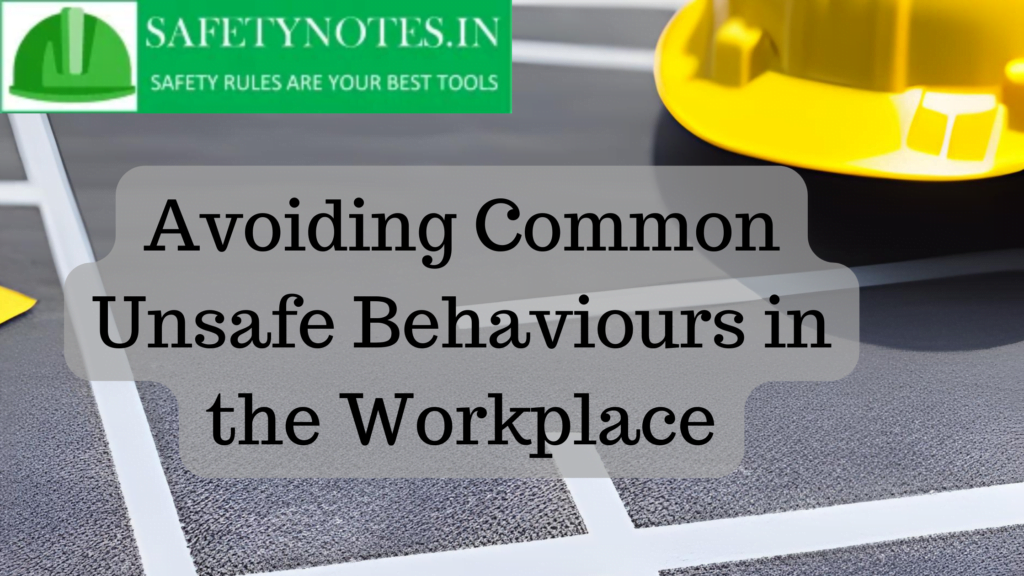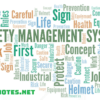
Introduction:
As a responsible and safety-conscious employee, it’s important to always keep in mind the potential risks and hazards that exist in the workplace. Unsafe behaviours and actions can lead to serious injury or even death. Workplace safety should be a top priority for every employee, regardless of the industry they work in or the tasks they perform.
In many cases, it’s common for employees to develop a false sense of security in their work environment. They may think that accidents or injuries can’t happen to them or that safety rules don’t apply to their particular situation. However, this mindset can be incredibly dangerous and can lead to serious consequences.
This is why it’s important to be aware of common unsafe behaviours that occur in the workplace, and to understand how to avoid them. By doing so, you can help to prevent accidents and injuries, and ensure that everyone in the workplace stays safe and healthy.
In this Toolbox Talk, we will discuss some of the most common unsafe behaviours in the workplace, the consequences of these behaviours, and how to avoid them. We will also provide some tips and techniques to help you stay safe and reduce your risk of injury. Remember, safety should always be your top priority, and it starts with understanding and avoiding unsafe behaviours.
Common Unsafe Behaviours in the Workplace:
There are a number of common unsafe behaviours that can occur in the workplace. It’s important to be aware of these behaviours and to understand the risks and consequences associated with them. Here are some of the most common unsafe behaviours in the workplace:
1.Lack of Personal Protective Equipment (PPE):
Personal Protective Equipment (PPE) is essential for protecting employees from workplace hazards. This includes items such as safety glasses, hard hats, gloves, and respirators. However, many employees fail to use the proper PPE or fail to use it correctly. This can result in serious injuries or illnesses, such as eye injuries, head injuries, hand injuries, and respiratory problems.
2. Ignoring Warning Signs and Labels:
Warning signs and labels are used to alert employees to potential hazards in the workplace. However, many employees ignore these signs or fail to read them carefully. This can lead to accidents or injuries, such as slips and falls, electrical shocks, and chemical exposures.
3. Horseplay and Roughhousing:
Horseplay and roughhousing may seem like harmless fun, but they can lead to serious injuries. Even a minor accident can result in serious injuries, such as broken bones, concussions, or neck injuries. Employees should avoid engaging in horseplay and roughhousing at all times.
4. Not Following Proper Lifting Techniques:
Improper lifting techniques can lead to serious back injuries, strains, and sprains. Employees should always use proper lifting techniques, such as bending at the knees, keeping the back straight, and avoiding twisting or jerking movements.
5. Failing to Report Hazards:
Employees should always report hazards and safety concerns to their supervisor or safety professional. Failing to report hazards can lead to serious accidents or injuries. It’s important to be aware of potential hazards and to take action to prevent them.
By being aware of these common unsafe behaviours and understanding how to avoid them, employees can help to create a safer and healthier workplace for everyone.
The Consequences of Unsafe Behaviours:
Unsafe behaviours and actions in the workplace can have serious consequences, both for the employee and for the organisation as a whole. Here are some of the potential consequences of unsafe behaviours in the workplace:
1.Personal Injury:
One of the most obvious consequences of unsafe behaviours is personal injury. This can include cuts, bruises, broken bones, strains, and sprains, as well as more serious injuries such as burns, amputations, and even death. In addition to the physical pain and suffering, personal injuries can result in lost wages, medical bills, and decreased quality of life.
2. Lost Productivity and Reduced Morale:
Unsafe behaviours can also lead to lost productivity and reduced morale in the workplace. When employees are injured, they may need to take time off work to recover, which can impact their productivity and the productivity of their colleagues. In addition, workplace accidents can cause stress and anxiety among employees, which can lead to decreased morale and job satisfaction.
3. Financial Costs:
Unsafe behaviours can also result in significant financial costs for the organisation. In addition to medical bills and lost productivity, workplace accidents can result in legal fees, fines, and increased insurance premiums. These costs can add up quickly and can have a significant impact on the organisation’s bottom line.
It’s important to remember that the consequences of unsafe behaviours can be far-reaching and long-lasting. By taking steps to prevent unsafe behaviours in the workplace, employees can help to avoid these negative outcomes and create a safer and healthier workplace for everyone.
Training and Education:
One of the best ways to prevent unsafe behaviors in the workplace is through training and education. By providing employees with the knowledge and skills they need to work safely, organizations can reduce the risk of accidents and injuries. Here are some tips for effective training and education:
1.Provide Clear and Concise Instructions:
When providing training and education, it’s important to provide clear and concise instructions. This can help to ensure that employees understand what is expected of them and how to perform their job safely. Use simple language and visuals to help employees understand complex concepts.
2. Tailor Training to the Job:
Different jobs and tasks may require different types of training. For example, an employee working with chemicals may need specialized training on how to handle those chemicals safely. Tailor your training to the specific needs of the job to ensure that employees have the knowledge and skills they need to work safely.
3. Use Real-Life Examples:
Using real-life examples can help to make training more engaging and effective. Share stories and examples of accidents and injuries that have occurred in the workplace, and discuss how those accidents could have been prevented. This can help to drive home the importance of working safely and help employees understand the real-life consequences of unsafe behaviours.
4. Provide Ongoing Training and Refresher Courses:
Training should not be a one-time event. Ongoing training and refresher courses can help to reinforce safe work practices and keep employees up-to-date on new hazards and safety protocols. Consider scheduling regular safety meetings or training sessions to keep safety top-of-mind for employees.
By providing effective training and education, organisations can help to prevent unsafe behaviours in the workplace and create a safer and healthier work environment for everyone.
Conclusion:
In conclusion, unsafe behaviours in the workplace can have serious consequences for both employees and organisations. By understanding the common unsafe behaviours and taking steps to prevent them, employees can help to create a safer and healthier workplace for everyone. Remember:
- Unsafe behaviours can happen to anyone, no matter how experienced or skilled they are.
- Identifying and reporting unsafe behaviours is everyone’s responsibility.
- Taking proactive steps to prevent unsafe behaviours is the best way to protect yourself and your colleagues from accidents and injuries.
- Training and education are essential for preventing unsafe behaviours and creating a safety culture in the workplace.
By working together to prevent unsafe behaviours, we can help to create a workplace where everyone can work safely and productively. Remember to always prioritise safety, ask questions when you’re unsure about something, and report any unsafe behaviours or hazards immediately. Thank you for your commitment to safety in the workplace.


